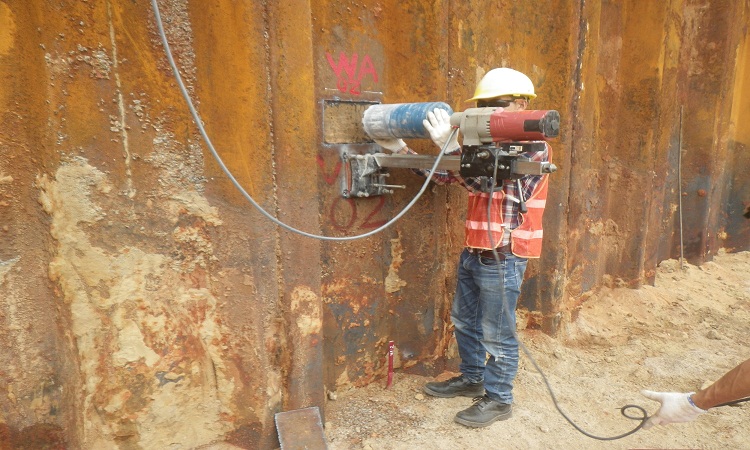A concrete core test is a very famous and well-established testing method for the compressive strength of the hardened concrete. Concrete core testing enables visual inspection of the interior regions of the concrete member which is also related to strength estimation. Concrete coring also enables to evaluate other properties of reinforced concrete framed structure by concrete core test.
In any case, the necessity to conduct concrete core tests generally arises out of the failure of concrete cubes/cylinders to get a more realistic idea of concrete strengths as actually existing in the structural elements.
Sampling of Concrete Core
It is very important that concrete core samples should be taken as per the guidelines given below:
- Cores should be taken using diamond-studded core bits.
- Cores tested for strength properties should have a minimum diameter of three times the maximum nominal size of coarse aggregate or 50 mm. whoever is greater.
- Wherever possible, cores tested for strength properties should have a length of at least twice their diameter.
- As far as possible reinforcing steel should not be included in a core to be tested for strength. The size, number, and location of steel reinforcement at the proposed core location can be determined either by using magnetic instruments such as rebar location meter (cover meter) or by radiographic ground-penetrating radar evaluation or by employing a pulsed radar system. If a core contains transverse reinforcing steel, some effect on the strength should be expected. There is a possibility of a reduction in the strength of the concrete core depending on the position of steel. This effect is more predominant when the steel is further away from the end of the core. The presence of steel parallel to the axis of the core is undesirable.
- Care should be taken to avoid cutting of electrical conduits or prestressing steel while extracting the concrete core.
- As far as possible, core drilling should completely penetrate the concrete section. This prevents the breaking of the core and facilitates its removal. On the other hand, if through drilling is not possible due to the size and configuration of the structure at the place where coring is planned, an extra 50 mm. should be drilled as an allowance for possible damage at the base of the core.
- A single core should not be used to evaluate a particular problem. When cores are taken to determine strength, a minimum of three cores are required to be removed at each location. The value of the strength of concrete in the core should be taken as the advantage of these cores.
- Particular attention needs to be paid while selecting the location of the core in vertical concrete members such as walls, deep beams, etc. this is due to variations of concrete properties with elevation due to differences in placing and compacting procedures, segregation, and bleeding. It is observed that generally, the strength of concrete decreases as its elevation within a placement in the member increases.
- The exact curing history of a structure is normally difficult to determine. Hence the effect of curing on the strength of cores is also uncertain. In the absence of moist curing, no increase in strength should be expected.
- The direction of drilling also affects the strength of cores. Cores drilled horizontally typically have lower strength than cores drilled vertically.
- While cutting the core, the structural integrity of the concrete across the full cross-section (c/s) may be affected to some extent. This aspect has to be considered while selecting the location where the core has to be taken.

Concrete Core Test Procedure
Concrete cores are usually cut by the rotary cutting tools with diamond bits. A cylindrical specimen is obtained with its ends being uneven, parallel, square, and embedded pieces of reinforcement.
The cores are visually inspected for giving specific attention towards the distribution of aggregate, compaction of concrete (air void visualization), and presence of steel, etc. the concrete core should be soaked in water, capped with molten sulfur so as to make its end plane, parallel and at the right angle. It is then tested in a compression testing machine in a moist condition as per BIS 1881: Part 4: 1970 or ASTM 42-77.

Use of Concrete Core Sample
- Water or gas permeability
- Chemical analysis
- ASHTO chloride permeability test
- Strength and Density determination
- Depth of carbonation of concrete
- Petrographic analysis

